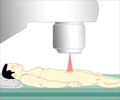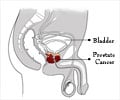A new study has found brachytherapy to be an effective means to reduce death rates in high-risk prostate cancer patients.

The findings by radiation oncologists at the Kimmel Cancer Center at Jefferson are reported online January 23 in the International Journal of Radiation Oncology,Biology,Physics.
Brachytherapy involves the precise placement of radiation sources directly at the site of a tumor and is typically used to treat low and intermediate risk prostate cancers. However, brachytherapy treatment for high-risk patients is less common and controversial, given in part to early retrospective studies that found it to be associated with lower cure rates compared to EBRT.
Many experts believe that these early series were limited by poor brachytherapy technique, and that high-quality contemporary brachytherapy may be an effective tool against high-risk prostate cancer.
"The study contradicts traditional policies of using brachytherapy in just low and intermediate risk patients by suggesting there may instead be an improvement in prostate cancer survival for high-risk patients," said co-author Timothy Showalter, M.D., assistant professor in the Department of Radiation Oncology at Thomas Jefferson University Hospital, and associate research member of Jefferson's Kimmel Cancer Center. "Although studies like this cannot prove an advantage for brachytherapy, our report does suggest that brachytherapy is no less effective than EBRT and should be considered for some men with high-risk prostate cancer."
Researchers identified 12,745 Surveillance, Epidemiology and End Results database patients diagnosed from 1988 to 2002 with high-grade prostate cancer of poorly differentiated grade and treated with brachytherapy (7.1 percent), EBRT alone (73.5 percent) or brachytherapy plus EBRT (19.1 percent). The team used multivariate models to examine patient and tumor characteristics associated with the likelihood of treatment with each radiation modality and the effect of radiation modality on prostate cancer-specific mortality.
Advertisement
Significant predictors of use of brachytherapy or brachytherapy plus EBRT were younger age, later year of diagnosis, urban residence and earlier T-stage.
Advertisement
"Today, for the most part, brachytherapy is not being used for these high-risk patients or even recommended," Dr. Shen said. "But if you look at the biology and theory behind it, it makes sense: you can really give a lot more dose with brachytherapy than with EBRT alone to the prostate. And this presents an opportunity for high-risk patients."
Source-Eurekalert

![Prostate Specific Antigen [PSA] & Prostate Cancer Diagnosis Prostate Specific Antigen [PSA] & Prostate Cancer Diagnosis](https://images.medindia.net/patientinfo/120_100/prostate-specific-antigen.jpg)













